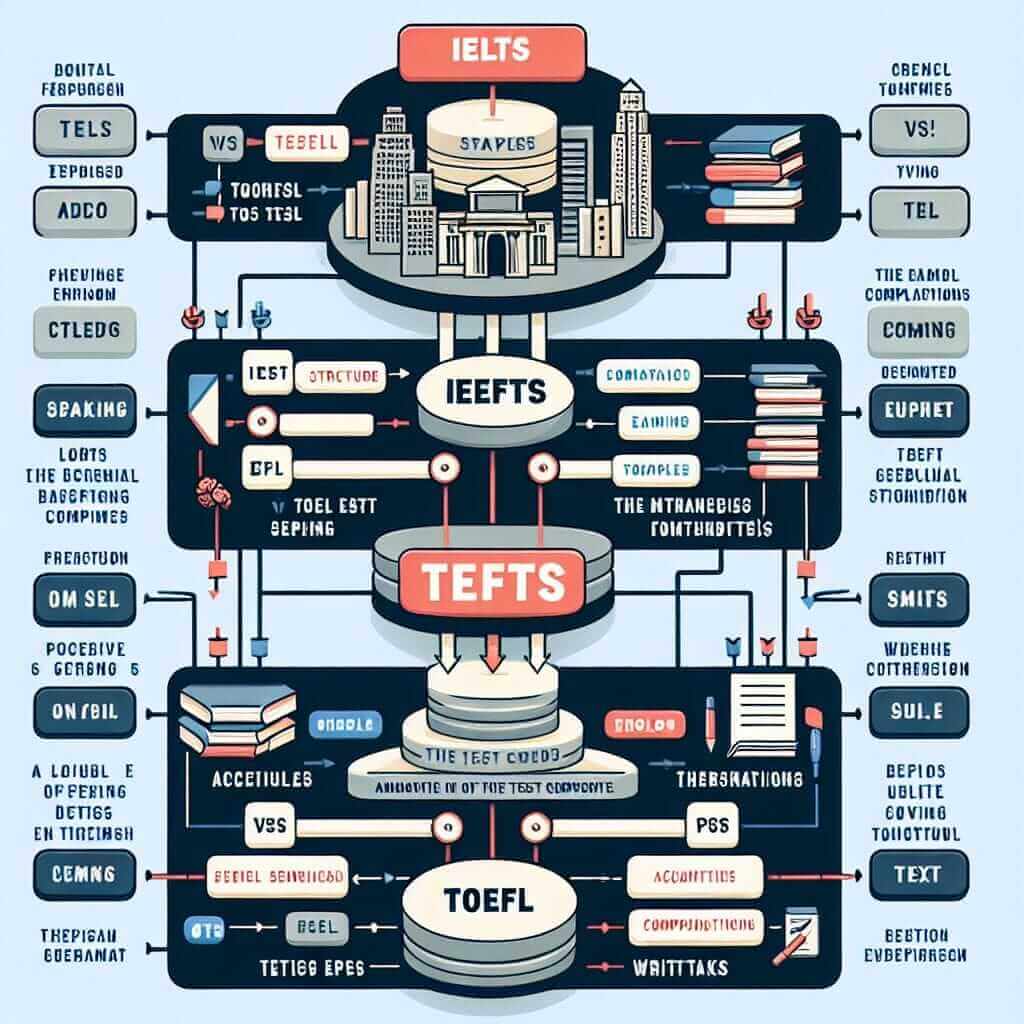For those of you embarking on the journey to conquer English proficiency tests, you’ve likely encountered two prominent acronyms: IELTS and TOEFL. These tests, gateways to academic and professional opportunities, often leave test-takers pondering: What exactly is the difference, and which one is right for me? This comprehensive guide will delve into the intricacies of both exams, equipping you with the knowledge to make an informed decision.
Understanding the Basics
IELTS: International English Language Testing System
IELTS, renowned for its British English focus, assesses your ability to use English for work, study, or migration purposes. This exam comes in two formats:
- Academic: Designed for university admissions and professional registration.
- General Training: Tailored for work experience, training programs, or migration to English-speaking countries like Australia, Canada, and New Zealand.
TOEFL: Test of English as a Foreign Language
TOEFL, administered by the Educational Testing Service (ETS), primarily focuses on North American English and is often preferred for admission to universities in the USA and Canada.
Key Differences: A Closer Look
While both exams assess your English language proficiency, several key distinctions exist:
| Feature | IELTS | TOEFL |
|---|---|---|
| Test Format | Paper-based or computer-delivered | Internet-based only (TOEFL iBT) |
| English Accent | British, Australian, North American | Primarily North American |
| Speaking Test | Face-to-face interview with an examiner | Recorded responses graded later |
| Writing Tasks | Task 1: Summarizing data (graph, chart, etc.) Task 2: Essay writing |
Two integrated tasks combining reading, listening, and writing skills |
| Scoring | Band score from 1 (non-user) to 9 (expert) | Score out of 120 (30 points per section) |
 IELTS vs TOEFL Comparison Chart
IELTS vs TOEFL Comparison Chart
Which Test is Right for You?
Choosing the right exam depends on several factors:
- University or Organization Requirements: Check the specific requirements of your desired institution or organization.
- Test Availability and Location: Consider test dates and locations that are convenient for you.
- Personal Preferences: Some test-takers might feel more comfortable with a face-to-face speaking test (IELTS), while others might prefer the structured format of TOEFL.
Sample IELTS Question and Analysis
Let’s analyze a typical IELTS Writing Task 2 question:
“Some people believe that the best way to improve public health is by increasing the number of sports facilities. Others, however, believe that other measures are required in addition to this. Discuss both views and give your own opinion.”
Analysis: This question requires you to:
- Present both sides of the argument: Discuss the benefits of increasing sports facilities and acknowledge the need for additional measures.
- Provide your opinion: Clearly state your viewpoint on the issue.
- Support your arguments: Use relevant examples and evidence to justify your stance.
Sample Band 8 Essay:
Public health, a cornerstone of any thriving society, is a multifaceted issue with no single solution. While some advocate for increased sports facilities as the primary solution, others recognize the need for a more comprehensive approach. This essay will delve into both perspectives before presenting my own viewpoint.
Proponents of expanding sports facilities argue that it encourages physical activity, combating sedentary lifestyles often associated with chronic diseases. Accessible gyms, swimming pools, and playing fields can motivate individuals to engage in exercise, thereby reducing the risk of obesity, heart disease, and diabetes. For instance, studies have shown a positive correlation between park proximity and physical activity levels among residents.
However, solely focusing on sports facilities neglects other crucial determinants of public health. Socioeconomic factors, access to healthcare, and education play equally significant roles. Individuals living in poverty-stricken areas might prioritize basic necessities over gym memberships. Similarly, lack of awareness regarding healthy lifestyles can hinder the effectiveness of even the most well-equipped sports centers.
Therefore, a holistic approach that combines infrastructure development with social and educational initiatives is paramount. Alongside building sports facilities, governments should prioritize affordable healthcare, healthy food subsidies, and public awareness campaigns promoting healthy habits. For instance, incorporating nutrition education into school curriculums can empower future generations to make informed choices.
In conclusion, while increasing sports facilities can undoubtedly contribute to improving public health, it should be part of a broader strategy. By addressing the multifaceted nature of this issue through a combination of infrastructure, social, and educational initiatives, we can pave the way for a healthier and more vibrant society.
Common Mistakes to Avoid
- Ignoring Task Instructions: Carefully read and understand the question prompt before attempting to answer.
- Lack of Cohesion and Coherence: Ensure your writing flows logically and connects ideas effectively using linking words and phrases.
- Insufficient Vocabulary and Grammatical Range: Showcase your language proficiency by using a variety of vocabulary and grammatical structures accurately.
Tips for IELTS and TOEFL Success
- Practice Regularly: Familiarize yourself with the test format and question types through consistent practice tests.
- Enhance Your Vocabulary: Expand your vocabulary base by reading extensively and noting down new words and their meanings.
- Focus on Fluency and Pronunciation: Practice speaking English regularly to improve your fluency and pronunciation.
- Seek Feedback: Ask a teacher or tutor to evaluate your writing and speaking skills and provide constructive criticism.
Choosing between IELTS and TOEFL marks the first step in your English proficiency journey. By understanding the nuances of each exam and dedicating yourself to consistent preparation, you can confidently approach your chosen test and unlock a world of opportunities.


